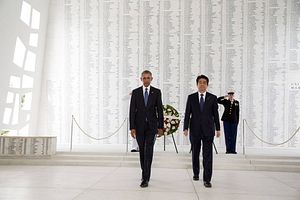The December visit of Japanese Prime Minister Shinzo Abe to Pearl Harbor, following U.S. President Barack Obama’s earlier groundbreaking trip to Hiroshima in May, represents a triumph for diplomatic efforts and the process of reconciliation between the two former wartime adversaries.
There was no compelling necessity for either Abe or Obama to have made these historic visits. They could have taken the view that Japan and the United States were already “reconciled enough,” through trading ties and diplomatic and security cooperation. But both men determined the investment in time, effort, and political capital to make the visits happen to be worthwhile. More importantly, they recognized that reconciliation is a process, not a singular event that takes peoples from reluctant partners to reconciled friends. Abe and Obama chose the harder route of “reconciling more” in a political world where we more commonly observe, with cynical resignation, issues as cans to be kicked down the road, often to be left for future administrations to deal with.
Leaving aside the short 1951 entry into Pearl Harbor made, without ceremony, by former Prime Minister Shigeru Yoshida, Abe’s visit truly broke new ground. So, why has this first, post-war, official visit just taken place? Primarily, this visit, and Obama’s earlier visit to Hiroshima, happened as a result of the two leaders taking a long-term view and behaving as statesmen. Recognizing the importance of the Japan-U.S. relationship in the broadest possible terms, including shared economic and security challenges, the leaders, through their respective visits to sacred grounds, showed what hitherto seemed un-doable could actually be done. Moreover, they seized a window of opportunity, which may not otherwise have remained open indefinitely.
For his part, Obama recognized the ongoing importance of Japan-U.S. cooperation. Japan stands apart, as a paradox to many other American allies in the Asia Pacific region, in that its bilateral relationship is stronger than that of some nations with which America has no history of conflict. How can this be rationalized?
Even during the 1945-1952 American occupation of Japan, the United States was largely magnanimous in victory, moving relatively quickly from a “punishment” phase (1945-1947), in which it disbanded the Japanese Imperial Army and conducted war crime trials and tribunals, toward a focus on societal, constitutional, and economic reconstruction. The United States helped to draft a new Japanese Constitution, which remains in place today. America in victory, however, was not only magnanimous, but also pragmatic. The nation that fought for and won independence from the British and their monarchy allowed the Emperor Showa (Hirohito) to survive. After stripping him of his divine status, the United States defined a modern symbolic role for the Emperor as head of state.
U.S.-promulgated democratic values were embraced by the Japanese people. Having demonstrated an earlier appetite for liberalism in the nascent pre-war “Taisho democracy” seen in the earlier 1912-1926 era, Japan was receptive to the new system. And Japan’s liberal democracy prevails today. Freedom House, in reviewing press freedom, freedom of speech, and political activism, has long determined Japan to be a free nation, furthermore ranking Japan in seventh place in its 2016 Internet Freedom analysis, above both the United Kingdom and France. Japan has placed democracy at the very core of the nation’s values, rather than simply asserting democratic aspirations. The lesson for America, in analyzing its most successful occupation and nation-building endeavor, should be that it successfully exported its democratic value system to Japan, but did so with flexibility, without imposing a facsimile of America in terms of its constitution and political structures.
What lessons are there for Japan? First, reconciliation takes time, in that the Abe and Obama visits took place only after more than seven decades of diplomacy. Such a process is a long-term endeavor, in which overnight miracles are few and far between. Second, successful reconciliation requires both parties to be fully engaged and committed. In that spirit, and unlike the unconditional surrender demanded of Japan that was required to bring the Pacific war to an end, America set no preconditions for the reconciliation process to commence. The U.S. approach demonstrated one of America’s virtues in accepting that friendship deserves a second chance.
For both nations, there is the valuable lesson that former adversaries do not have to agree on every historical point for a reconciliation process to move forward. For example, and most remarkably, views still differ starkly on the military necessity, or otherwise, of the two U.S. atomic bombings of the cities of Hiroshima and Nagasaki. The moral justification for these attacks is also widely questioned. Yet the absence of unanimity of opinion has not derailed the reconciliation process. Japan and America, as nations, have reached the point at which they can agree to differ on historic issues where there is unlikely ever to be a clear consensus. Such issues will continue to be debated between historians for the decades to come. Politicians, however, should have a different priority. They need to move forward for the common good. This is perhaps the most useful and powerful post-conflict message.
Yukari Easton is an ACE-Nikaido Fellow at the East Asian Studies Center at University of Southern California whose research focus is upon international relations, diplomacy and security issues in the Asia-Pacific region. Previously, she worked for ten years in international banking in Europe and Asia.

































